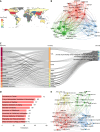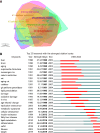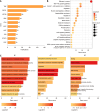Mapping the evolution of liver aging research: A bibliometric analysis
- PMID: 39534417
- PMCID: PMC11551677
- DOI: 10.3748/wjg.v30.i41.4461
Mapping the evolution of liver aging research: A bibliometric analysis
Abstract
Background: With the increasing of the global aging population, healthy aging and prevention of age-related diseases have become increasingly important. The liver, a vital organ involved in metabolism, detoxification, digestion, and immunity, holds a pivotal role in the aging process of organisms. Although extensive research on liver aging has been carried out, no bibliometric analysis has been conducted to evaluate the scientific progress in this area.
Aim: To analyze basic knowledge, development trends, and current research frontiers in the field via bibliometric methods.
Methods: We conducted bibliometric analyses via a range of analytical tools including Python, the bibliometrix package in R, CiteSpace, and VOSviewer. We retrieved publication data on liver aging research from the Web of Science Core Collection Database. A scientific knowledge map was constructed to display the contributions from different authors, journals, countries, institutions, as well as patterns of co-occurrence keywords and co-cited references. Additionally, gene regulation pathways associated with liver aging were analyzed via the STRING database.
Results: We identified 4288 articles on liver aging, authored by 24034 contributors from 4092 institutions across 85 countries. Notably, the years 1991 and 2020 presented significant bursts in publication output. The United States led in terms of publications (n = 1008, 25.1%), citations (n = 55205), and international collaborations (multiple country publications = 214). Keywords such as "lipid metabolism", "fatty liver disease", "inflammation", "liver fibrosis" and "target" were prominent, highlighting the current research hotspots. Notably, the top 64 genes, each of which appeared in at least 8 articles, were involved in pathways essential for cell survival and aging, including the phosphatidylinositol 3-kinase/protein kinase B, Forkhead box O and p53 signaling pathways.
Conclusion: This study highlights key areas of liver aging and offers a comprehensive overview of research trends, as well as insights into potential value for collaborative pursuits and clinical implementations.
Keywords: Aging; Bibliometric; CiteSpace; Gene regulation; Liver; R language; VOSviewer.
©The Author(s) 2024. Published by Baishideng Publishing Group Inc. All rights reserved.
Conflict of interest statement
Conflict-of-interest statement: All the authors report no relevant conflicts of interest for this article.
Figures











Similar articles
-
Insight into the research history and trends of total anomalous pulmonary venous connection: a bibliometric analysis.J Cardiothorac Surg. 2024 May 11;19(1):285. doi: 10.1186/s13019-024-02787-8. J Cardiothorac Surg. 2024. PMID: 38730414 Free PMC article.
-
Mapping the Evolution of Digital Health Research: Bibliometric Overview of Research Hotspots, Trends, and Collaboration of Publications in JMIR (1999-2024).J Med Internet Res. 2024 Oct 17;26:e58987. doi: 10.2196/58987. J Med Internet Res. 2024. PMID: 39419496 Free PMC article.
-
Evolution and global research trends of immunity in diabetic nephropathy: a bibliometric and visual analysis from 2004 to 2023.Int Urol Nephrol. 2024 Oct;56(10):3307-3321. doi: 10.1007/s11255-024-04081-x. Epub 2024 May 17. Int Urol Nephrol. 2024. PMID: 38758346 Free PMC article.
-
Global trends in tumor-associated neutrophil research: a bibliometric and visual analysis.Front Immunol. 2025 Mar 14;16:1478092. doi: 10.3389/fimmu.2025.1478092. eCollection 2025. Front Immunol. 2025. PMID: 40160822 Free PMC article.
-
Global trends and hotspots of treatment for nonalcoholic fatty liver disease: A bibliometric and visualization analysis (2010-2023).World J Gastroenterol. 2023 Oct 7;29(37):5339-5360. doi: 10.3748/wjg.v29.i37.5339. World J Gastroenterol. 2023. PMID: 37899789 Free PMC article. Review.
Cited by
-
Delaying liver aging: Analysis of structural and functional alterations.World J Gastroenterol. 2025 Apr 21;31(15):103773. doi: 10.3748/wjg.v31.i15.103773. World J Gastroenterol. 2025. PMID: 40309235 Free PMC article.
References
-
- Ma S, Chi X, Cai Y, Ji Z, Wang S, Ren J, Liu GH. Decoding Aging Hallmarks at the Single-Cell Level. Annu Rev Biomed Data Sci. 2023;6:129–152. - PubMed
-
- Wu Z, Qu J, Zhang W, Liu GH. Stress, epigenetics, and aging: Unraveling the intricate crosstalk. Mol Cell. 2024;84:34–54. - PubMed
-
- López-Otín C, Blasco MA, Partridge L, Serrano M, Kroemer G. Hallmarks of aging: An expanding universe. Cell. 2023;186:243–278. - PubMed
MeSH terms
LinkOut - more resources
Full Text Sources
Medical
Research Materials
Miscellaneous

